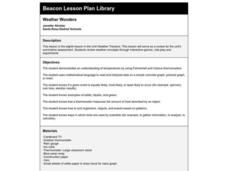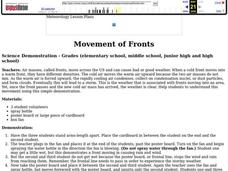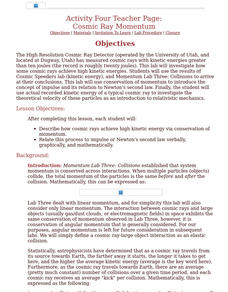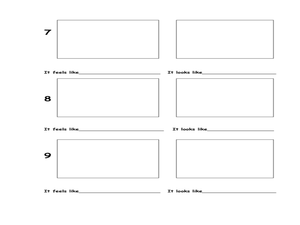Curated OER
Water as a Cycle
Students collaborate with a partner to create a large diagram containing one aspect of the water cycle. They are encouraged to include academic language and pictures for their presentation. Their is a peer evaluation sheet that is...
Curated OER
Movement of Fronts
Students use a demonstration in order to learn abou the movement of weather fronts.
Curated OER
Cosmic Ray Momentum
Students describe how cosmic rays achieve high kinetic energy via conservation of momentum.
Curated OER
Making Layered Hail Stones
Young scholars explore how hail forms in the atmosphere, why hailstones are layered, and what accretion is. They also learn what supercooled liquids are.
Curated OER
Spontaneous Britishstrokes
Students are introduced to Chinese painting and they examine how Daoist phiolosophy influenced artistic style. They discuss how art and artistic technique as a reflection of Daoist culture. Students discuss how art is a reflection of...
Curated OER
Instrumental And Orchestral Development
Students use the computer software "Sibelius" to investigate the development of the Orchestra and specific instruments throughout human history. This lesson can be used in conjunction with other lessons or as a stand-alone, small group...
Curated OER
The Function Box
Students look around classroom and identify any patterns they see, describe patterns and explain why they are patterns, use pencil to demonstrate arithmetic patterns by tapping, practice predicting patterns by using Function Box, and...
Curated OER
Exploring Marine Objects
Students identify the sources of water on Earth. In this life science lesson, students list the different plants and animals that live in the ocean. They explore marine objects in the lab and draw them.
University Corporation for Atmospheric Research
Ucar: Clouds in the Air: Why Are They There?
An experiment that demonstrates why there are clouds in the sky. Start with air, invisible water vapor, particles we call condensation nuclei, and air pressure...the cloud comes later!
Science Education Resource Center at Carleton College
Serc: Investigating How Do Clouds Form? What Are the Different Types of Clouds?
In this investigation, students will observe and learn about the different types of clouds and be able to explain in their own words how clouds are formed. They will also observe an experiment illustrating how clouds form.
Science Education Resource Center at Carleton College
Serc: Cloud Inquiry Investigation & Id
Students describe and create an experiment to indicate that a cloud will form under specific conditions.
American Geosciences Institute
American Geosciences Institute: Earth Science Week: Sky and Cloud Windows
In this activity, students will conduct experiments or participate in demonstrations to answer questions about sky and weather phenomena.
ReadWriteThink
Read Write Think: Lonely as a Cloud: Using Poetry to Understand Similes
Learners identify similes in poetry and gain experience in using similes as a poetic device in their own work.














